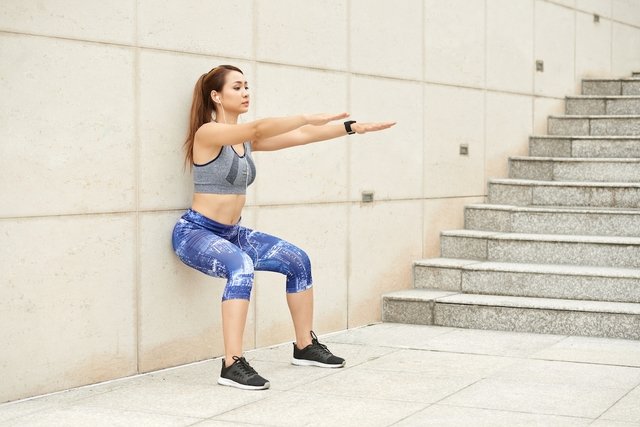Wall Pilates is a type of Pilates in which the wall is used as support to perform exercises and is used to tone muscles, improve flexibility and cardiorespiratory capacity.
Furthermore, Pilates on the wall is a low-impact exercise, being a good option for people who are starting to practice physical exercises, and can be done with strengthening, stretching and mobility exercises, such as the bridge, the plank or the squat, for example.
Pilates on the wall can be done at home, in the gym or outdoors in places that have a wall to support yourself, and it is important to have guidance from a physical education professional to avoid injuries.

What is it for
Pilates on the wall has several health benefits, such as:
- Strengthen and stabilize muscles;
- Increase muscle tone and strength;
- Improve balance;
- Increase flexibility and range of movements;
- Relieve back pain;
- Increase physical resistance;
- Improve posture;
- Increase cardiorespiratory capacity;
- Relieve stress and increase disposition and concentration;
- Increase body awareness;
- Helps in recovery from injuries in athletes.
Furthermore, Pilates on the wall helps to increase cardiorespiratory capacity, blood circulation and blood oxygenation. See other health benefits of pilates.
Pilates on the wall makes you lose weight?
Pilates on the wall can help you lose weight, as it increases muscle tone and strength, which can help speed up your metabolism and promote weight loss. Understand how pilates can help you lose weight.
However, to lose weight, Pilates on the wall must be part of a balanced, nutritious and diverse diet guided by a nutritionist, in order to have a calorie deficit, and promote healthy weight loss.
Read too: Pilates or weight training: Which is better?
How to make
Pilates on the wall is done by performing exercises such as planks or squats, for example, using the wall as support.
This type of exercise is normally done using your own body weight, but you can also use some objects, such as dumbbells, balls or shin guards, for example, as instructed by the physical education professional.
Pilates exercises on the wall
Some examples of Pilates wall exercises are:
1. Bridge on the wall
The wall bridge is a wall Pilates exercise that helps stabilize muscles such as the glutes, back and abdomen.
To bridge the wall, you must:
- Lie face up, with a distance of about 25 centimeters between the wall and the buttocks;
- Bend your knees and place your feet and heels on the wall, keeping your arms aligned with your body;
- Contract your abs and glutes and press the soles of your feet against the wall;
- Raise your hips off the floor until your body forms a straight line from your knees to your head;
- Hold this position for 30 seconds and lower your hips.
To increase the difficulty of the exercise, while in the bridge position, instead of lowering your hips, you can move one foot away from the wall, raising your leg towards your torso and then repeat with the other leg. This movement is as if the person were marching.
2. Wall squats
The Pilates exercise on the squat wall can be performed with your own body weight or with the use of a ball or dumbbell, for example.
To do wall squats, you must:
- Standing, lean your back against the wall. Legs should be shoulder-width apart;
- Slowly descend by bending your knees, with your spine resting on the wall;
- Your knees must form a 90-degree angle and not extend beyond your toes;
- Your arms should be stretched out in front of your body, parallel to the floor;
- Remain in this position for a few seconds.
If using a ball to perform wall squats, the ball must be positioned between the wall and the person’s back.
When using a dumbbell or other type of weight, you must hold it with your hands, and your arms must be stretched out in front of your body. The ball can also be used in this movement.
Read too: 6 Pilates ball exercises to tone your body
3. Plank on the wall
The wall plank is considered a complete exercise, that is, it works several areas of the body, including the core, abdominal and back muscles.
To make the plank on the wall you must:
- Stay in the position on all fours, on a yoga mat, with your feet close to the wall;
- Keep your forearms stretched flat on the floor and place the soles of your feet against the wall;
- Keep your head and body straight, aligned with your spine, and your abdomen and glutes contracted;
- Stay still in this position for as long as you can.
You can start the wall plank for 15 to 30 seconds and gradually increase the time.
4. Push-up on the wall
Wall push-ups mainly work the pectoral muscles, deltoids and triceps, helping to strengthen and tone the chest, shoulders and arms, as well as helping to improve posture and balance.
To do wall push-ups you must:
- Position yourself standing in front of a wall, one or two steps back;
- Stretch your arms and rest your palms on the wall at chest height, keeping your legs straight and your feet flat on the floor;
- Slowly bend your elbows, leaning your torso toward the wall. The body must remain straight and the head aligned with the spine;
- Slowly raise your torso back to the starting position, pushing against the wall with your hands;
- Repeat the movement from the starting position.
You can do 15 to 20 repetitions of this exercise in 2 to 3 sets.
It is important to keep your abdomen and glutes contracted while performing wall push-ups and you should not move your hips to avoid injuries. See other ways to do push-ups and the benefits.
5. Wall sit-ups
Wall crunches help strengthen your abs and core muscles.
To do wall sit-ups you must:
- Lie on your back, resting your feet on the wall, with your knees bent at a 90-degree angle with your hips. This is the same position as the wall bridge exercise;
- Keep your arms straight and aligned with your body;
- Contract your abdomen and glutes;
- Slowly raise your torso and shoulder blades, keeping your lower back always supported on the floor;
- Maintain this position and take your hands off the floor, raising and lowering your hands with your arms straight at your sides;
- Return to starting position.
It is important that your abdomen remains contracted throughout the exercise.
Possible risks
Pilates on the wall is an exercise that has few risks as it is a low-impact exercise, however, injuries to the joints or spine may worsen, especially when done without guidance from a physical education professional or physiotherapist.
Care when doing Pilates on the wall
To do Pilates on the wall safely, some precautions are important, such as:
- Wear non-slip socks or suitable sneakers to avoid slipping off the wall and causing injuries;
- Always keep your abdomen contracted during exercises;
- Respect the limits of your own body, not pushing too hard and stopping the exercise if you feel pain or discomfort;
- Start training little by little, with lighter exercises, especially in the case of people who are starting to practice physical exercises in order to avoid injuries.
Ideally, Pilates on the wall should be done after an evaluation with a cardiologist to check the general health status, especially of the cardiovascular system, and perform the exercises with guidance from a physical education professional or physiotherapist.

Sign up for our newsletter and stay up to date with exclusive news
that can transform your routine!
Warning: Undefined array key "title" in /home/storelat/public_html/wp-content/plugins/link-whisper-premium/templates/frontend/related-posts.php on line 12
Warning: Undefined array key "title_tag" in /home/storelat/public_html/wp-content/plugins/link-whisper-premium/templates/frontend/related-posts.php on line 13



